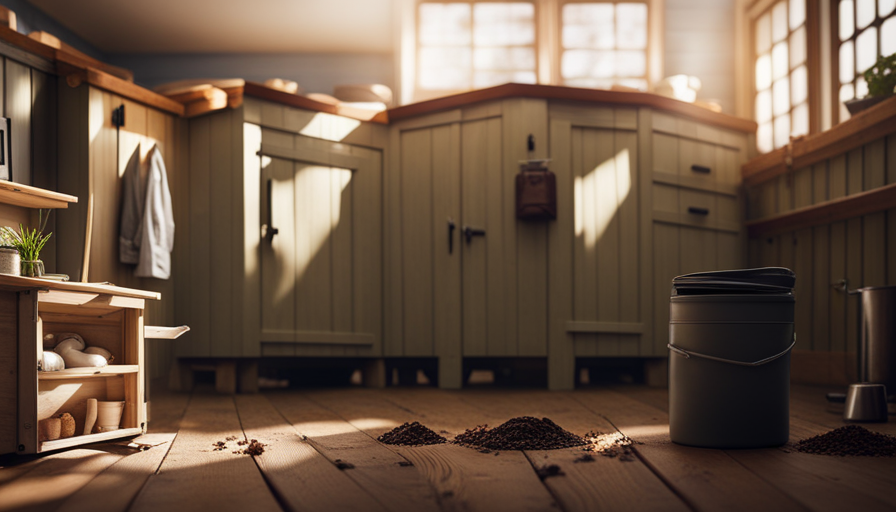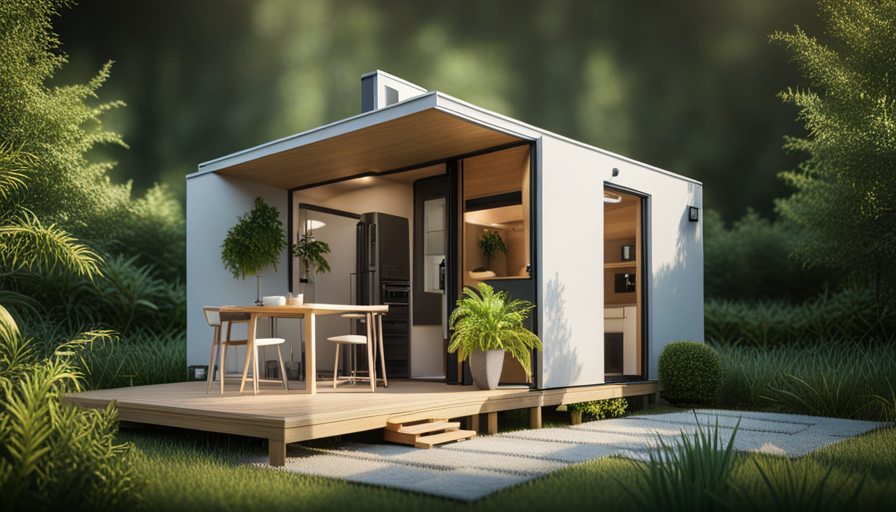Have you ever been curious about how tiny homes are able to operate in a sustainable manner, despite their constrained space? The secret is found in one of the most groundbreaking and environmentally friendly options available – the composting toilet. That’s correct – a toilet that transforms waste into compost rich in nutrients.
Composting toilets are gaining popularity in the tiny house movement due to their numerous benefits. Not only do they save water and reduce environmental impact, but they also provide a practical solution for those living off-grid or in areas with limited access to sewage systems.
In this article, we will delve into the world of composting toilets and explore how they work in harmony with tiny houses. From understanding the science behind composting toilets to choosing the right one for your needs and addressing common concerns, we will cover it all.
So, get ready to embrace sustainable living and discover the wonders of a composting toilet in your tiny house.
Key Takeaways
- Composting toilets are an innovative and eco-friendly solution for tiny houses, turning waste into nutrient-rich compost.
- They save water and reduce environmental impact, making them practical for off-grid living or areas with limited access to sewage systems.
- Proper maintenance, such as adding bulking agents and emptying the waste compartments, is necessary for odor control and effective waste management.
- Installing a composting toilet requires plumbing and ventilation system installation, as well as proper waste disposal methods for safe and environmentally-friendly practices.
Understanding Composting Toilets
So, you’re probably wondering how a tiny house works with a composting toilet, right? Well, let me explain it to you.
Composting toilets are a great alternative to traditional flush toilets, especially in tiny houses where space is limited. These toilets work by separating the liquid and solid waste, allowing the solid waste to decompose into compost over time.
Composting toilet maintenance is fairly simple. It involves regularly adding a bulking agent, such as sawdust or coconut fiber, to the solid waste compartment to aid in the decomposition process. This helps control odors and promotes the breakdown of waste into usable compost. Additionally, the liquid waste compartment needs to be emptied periodically, but this can be done easily with a drain hose or container.
Now, let’s talk about the benefits of composting toilets in tiny houses. Firstly, they’re eco-friendly. By turning waste into compost, these toilets reduce water consumption and eliminate the need for traditional sewage systems. They also save space, as there’s no need for a large septic tank or plumbing infrastructure.
Composting toilets are a practical and sustainable solution for tiny houses. They require minimal maintenance and offer numerous benefits, making them a popular choice among tiny house owners.
Benefits of Composting Toilets in Tiny Houses
Imagine living in a space where waste management becomes a seamless and eco-friendly process, leaving you with more time to focus on the joys of tiny house living. Composting toilets offer numerous benefits for those living in tiny houses.
One of the main advantages is that they are environmentally friendly. Unlike traditional flush toilets, composting toilets don’t require water to operate, which helps conserve this precious resource. Additionally, they eliminate the need for sewage infrastructure, reducing the environmental impact associated with wastewater treatment and transportation.
Composting toilets also provide a natural way to recycle human waste. The waste is broken down through a process called composting, where microorganisms decompose it into nutrient-rich compost. This compost can then be used to fertilize plants, closing the nutrient cycle and reducing the need for chemical fertilizers.
Furthermore, these toilets are odorless when properly managed, as the waste is kept separate from the living space and covered with a layer of organic matter like sawdust. This ensures that unpleasant odors are minimized or eliminated entirely.
Transitioning into the next section about how composting toilets work, it’s important to understand the benefits they offer in order to appreciate the functioning of these innovative waste management systems.
How Composting Toilets Work
Composting toilets operate by utilizing microorganisms to break down human waste into nutrient-rich compost, providing an eco-friendly solution for waste management. These toilets are designed to separate liquid and solid waste, allowing for proper composting. The solid waste is mixed with organic material such as sawdust or coconut coir to create a balanced carbon-to-nitrogen ratio. This mixture helps in the decomposition process and prevents odors from escaping.
Composting toilet maintenance is relatively simple. Regularly adding organic material to the toilet helps maintain the composting process and control odor. Emptying the solid waste container is required every few weeks, depending on usage. The composting material needs to be properly managed by turning it regularly to ensure proper decomposition. Additionally, it is important to monitor the moisture level of the composting material, as too much moisture can hinder the decomposition process.
Composting toilets are designed to minimize odor, but odor control may still be a concern in some cases. To reduce odor, some composting toilets use fans or ventilation systems to ensure proper airflow. Adding a layer of organic material after each use can also help control odors by absorbing any potential smells.
Choosing the right composting toilet for your tiny house is an important decision.
Choosing the Right Composting Toilet for Your Tiny House
When it comes to picking the perfect privy for your petite dwelling, finding the fitting composting commode is crucial. Choosing the right composting toilet for your tiny house involves considering a few key factors.
Firstly, you need to determine the size of the toilet that can fit comfortably in your limited space. Compact models are available that can easily fit into small bathrooms or even closets.
Secondly, you should consider the capacity of the toilet. This refers to how much waste it can hold before it needs to be emptied. It’s important to choose a toilet with a capacity that suits your needs and lifestyle.
Additionally, you should look into the ventilation system of the composting toilet. Proper ventilation helps in reducing odors and promoting the decomposition of waste.
Lastly, consider the maintenance requirements of the toilet. Some toilets require more frequent maintenance, while others are relatively low-maintenance. Researching composting toilet maintenance tips can help you make an informed decision.
In the next section, we will explore the process of installing a composting toilet in your tiny house, which is the next step in creating a sustainable and efficient waste management system.
Installing a Composting Toilet in Your Tiny House
When it comes to installing a composting toilet in my tiny house, there are three key points to consider: the plumbing and hookup process, ventilation system installation, and proper waste disposal.
First, I need to ensure that the toilet is properly connected to my plumbing system, which may require some modifications or additions.
Next, I must install a ventilation system to eliminate any odors and promote proper decomposition of the waste.
Finally, I must educate myself on the proper methods of waste disposal, as composting toilets require specific procedures to ensure safe and environmentally-friendly disposal.
Plumbing and Hookup Process
To successfully set up a composting toilet in a tiny house, it’s crucial to understand the plumbing and hookup process.
When it comes to plumbing installation, it’s important to ensure that the toilet is properly connected to a water source, either through a direct hookup or a gravity-fed system. This will allow for the necessary water flow to aid in waste management.
Additionally, it’s essential to have a drainage system in place, which can vary depending on local regulations and personal preferences. This may involve connecting the composting toilet to a separate gray water tank or directly to a septic system.
By understanding and implementing these plumbing components correctly, you can effectively manage waste in your tiny house.
As we move on to the next section, let’s explore the installation of the ventilation system.
Ventilation System Installation
Now that you’ve got the plumbing and hookup process sorted, let’s dive into the invigorating installation of the ventilation system in your cozy abode. A ventilation system is a crucial component of any tiny house with a composting toilet, as it helps maintain a fresh and odor-free environment. Not only does it eliminate unpleasant smells, but it also prevents the buildup of harmful gases like methane and ammonia.
To give you a clear idea of how the ventilation system works, let’s take a look at the table below:
| Ventilation System Benefits | Ventilation System Maintenance |
|---|---|
| Removes odors | Regular cleaning |
| Prevents gas buildup | Checking fan operation |
| Ensures fresh air flow | Replacing filters |
By regularly cleaning the ventilation system and checking the fan operation, you can ensure its optimal performance. Additionally, replacing filters as needed will maintain the quality of the air inside your tiny house.
Now that we’ve covered the installation and maintenance of the ventilation system, let’s move on to discussing proper waste disposal.
Proper Waste Disposal
Proper waste disposal ensures a clean and hygienic living environment in your cozy abode. When it comes to managing waste in a tiny house with a composting toilet, there are a few key considerations.
Firstly, it’s important to separate solid and liquid waste to optimize the composting process. Solid waste should be covered with a composting material like sawdust or peat moss, which helps control odor and aids in decomposition.
Liquid waste can be diverted to a separate container or used as a fertilizer in the garden, as long as it’s diluted properly.
Additionally, regular maintenance and cleaning of the toilet and composting system are essential to prevent any potential issues and ensure effective waste management.
By following these steps, you can minimize your environmental impact and maintain a sustainable lifestyle in your tiny house.
Managing Waste in a Composting Toilet
When using a composting toilet in a tiny house, you’ll need to carefully manage waste in order to maintain optimal functionality. Here are some tips to help you effectively manage waste in your composting toilet:
-
Regularly add bulking material: Adding bulking material, such as sawdust or coconut coir, helps create air pockets in the toilet and aids in the composting process.
-
Control moisture levels: It’s important to maintain the right moisture levels in the toilet. Too much moisture can lead to odor and slow down the composting process, while too little can hinder decomposition. Monitor and adjust as needed.
-
Properly dispose of solid waste: It’s crucial to ensure that only organic waste goes into the composting toilet. Avoid flushing non-biodegradable items or chemicals, as they can disrupt the composting process and harm the environment.
-
Composting toilet troubleshooting: Regularly check for any issues with the composting toilet, such as odor or incomplete decomposition. Follow troubleshooting guidelines provided by the manufacturer to address and resolve any problems.
-
Composting toilet maintenance: Regularly clean and maintain your composting toilet. This includes emptying the compost bin when necessary, cleaning the toilet bowl, and performing routine maintenance tasks as recommended by the manufacturer.
By effectively managing waste in your composting toilet, you can ensure its optimal functionality and promote a more sustainable lifestyle.
Now, let’s address some concerns and challenges related to composting toilets.
Addressing Concerns and Challenges
Addressing concerns and challenges with composting toilets can help create a more sustainable and eco-friendly living environment in your tiny home.
One common concern is the potential odor that may arise from using a composting toilet. However, by properly managing the composting process, this issue can be minimized. Regularly adding bulking agents, such as sawdust or coconut coir, can help absorb moisture and reduce odor. Additionally, ensuring proper ventilation and maintaining a balance of carbon and nitrogen-rich materials can further prevent unpleasant smells.
Another challenge that may arise when using a composting toilet is the maintenance and management of the compost pile. It is important to regularly monitor and turn the compost to facilitate decomposition and prevent the pile from becoming too wet or too dry. This can be achieved by following proper guidelines and recommendations provided by the manufacturer of the composting toilet.
Furthermore, some individuals may have concerns about the capacity and frequency of emptying the composting toilet. However, modern composting toilets are designed to handle a significant amount of waste and can typically go several weeks or even months without requiring emptying, depending on the size of the unit and the number of users.
Addressing concerns and overcoming challenges with composting toilets is essential to ensure a successful and sustainable experience in a tiny home. By understanding and implementing proper maintenance practices, individuals can enjoy the benefits of a composting toilet without compromising hygiene or comfort.
In the subsequent section about composting toilet regulations and legal considerations, we will explore the guidelines and requirements that need to be followed when installing and using a composting toilet in a tiny home.
Composting Toilet Regulations and Legal Considerations
Now that we’ve addressed some of the concerns and challenges of using a composting toilet in a tiny house, let’s take a closer look at the regulations and legal considerations surrounding this alternative sanitation option.
Composting toilets are becoming increasingly popular, especially in eco-friendly and off-grid communities. However, it’s important to note that regulations regarding composting toilets can vary depending on your location. Before installing a composting toilet in your tiny house, it’s crucial to research and understand the local regulations and requirements. This may include obtaining permits or certifications to ensure compliance with health and safety standards.
Additionally, some areas may have specific guidelines for the disposal of composted waste. It’s essential to follow these guidelines to prevent any environmental or health risks.
It’s also worth considering any legal considerations that may arise when using a composting toilet in a tiny house. For example, if you plan on parking your tiny house on someone else’s property, you may need to obtain permission to use a composting toilet. Landlords or homeowners associations may have specific rules or restrictions regarding alternative sanitation systems.
Understanding and adhering to composting toilet regulations and legal considerations is vital to ensure a smooth and compliant experience. With that in mind, let’s now explore some tips for maintaining a composting toilet in a tiny house.
Tips for Maintaining a Composting Toilet in a Tiny House
To ensure a smooth and compliant experience with your composting toilet, it’s essential for you to follow these tips for maintaining and keeping your alternative sanitation system in top shape. Proper maintenance is crucial to prevent any odors from developing and to ensure the efficient breakdown of waste materials.
First and foremost, regular cleaning is key to maintaining odor control. Emptying the solid waste container and adding sawdust or a composting medium after each use will help neutralize any unpleasant smells. Additionally, regularly cleaning the urine diverter and ensuring it’s free from any blockages will prevent any urine odor from lingering.
Maintaining the correct moisture level is also important. It’s essential to add the right amount of bulking material, such as sawdust or coconut coir, to help absorb excess moisture and promote proper composting. This will prevent the accumulation of liquid and the development of foul odors.
Furthermore, monitoring the temperature and ventilation of your composting toilet is crucial for optimal odor control. Keeping the temperature within the recommended range and ensuring proper airflow will aid in the decomposition process and minimize any potential odor issues.
Embracing sustainable living in a tiny house with a composting toilet requires diligent composting toilet maintenance. By following these tips and regularly tending to your system, you can enjoy an odor-free and efficient alternative sanitation solution.
Conclusion: Embracing Sustainable Living in a Tiny House with a Composting Toilet
If you think living sustainably in a small space with an eco-friendly waste management system is a piece of cake, think again! Maintaining a composting toilet in a tiny house requires dedication and effort, but the rewards are worth it.
By embracing sustainable living with a composting toilet, you not only reduce your ecological footprint but also save money on water bills and contribute to a healthier environment.
Here are some key tips for maintaining a composting toilet in your tiny house:
-
Regularly monitor the composting process: Keep an eye on the moisture levels and temperature inside the composting chamber. Adjust the balance of organic material, such as sawdust or coconut coir, to maintain optimal conditions for decomposition.
-
Empty the solids container when needed: Depending on the size of your composting toilet and the number of occupants in your tiny house, you may need to empty the solids container every few weeks. Properly dispose of the composted waste in a designated area or compost pile.
-
Clean and sanitize the toilet regularly: Maintain hygiene by cleaning the toilet bowl and seat with non-toxic cleaning products. Sanitize the surfaces to prevent the growth of harmful bacteria.
Embracing sustainable living in a tiny house with a composting toilet is a step towards a more eco-friendly lifestyle. With proper composting toilet maintenance and sustainable waste management practices, you can make a positive impact on the environment while enjoying the benefits of a compact and efficient living space.
Frequently Asked Questions
Are composting toilets legal in all areas for use in tiny houses?
Composting toilets aren’t legal in all areas for use in tiny houses. The legality of composting toilets varies depending on local building codes and regulations. However, in many areas, they’re allowed and even encouraged as a sustainable and eco-friendly option.
When installing a composting toilet in a cold climate, it’s important to ensure proper insulation and ventilation to prevent freezing. Maintenance frequency depends on the type of composting toilet, but generally, they require regular emptying and cleaning.
It’s important to use toilet paper that’s specifically designed for composting toilets to avoid potential clogs. While there are potential health risks associated with composting toilets, proper maintenance and hygiene practices can minimize these risks.
Can I use a composting toilet in my tiny house if I live in a cold climate?
Living in a cold climate and using a composting toilet in my tiny house can pose some challenges. The low temperatures can slow down the decomposition process, making it harder for the waste to break down effectively. However, there are solutions to overcome this.
Insulating the toilet and using a heating element can help maintain the optimal temperature for decomposition. Alternatively, in cold climates, some tiny house owners opt for incinerating toilets or traditional plumbing systems as alternatives to composting toilets.
How often do I need to empty the composting bin in a composting toilet?
Emptying frequency of the composting bin in a composting toilet depends on several factors such as the size of the bin and the number of people using it. Generally, it’s recommended to empty the bin every 3 to 6 months.
The composting process breaks down waste through the use of aerobic bacteria, which require oxygen, moisture, and the right temperature to thrive. Regularly turning the waste and adding bulking agents like sawdust can help accelerate the composting process and reduce odor.
Can I use regular toilet paper in a composting toilet?
Sure, you can absolutely use regular toilet paper in a composting toilet. However, if you’re looking for composting toilet alternatives or eco-friendly options, there are some great choices available.
You can opt for recycled or bamboo toilet paper, which is gentler on the environment. These alternatives break down more easily and are better suited for composting.
So, while regular toilet paper is fine, there are definitely eco-friendly options to consider for a more sustainable approach.
Are there any health risks associated with using a composting toilet in a tiny house?
Using a composting toilet in a tiny house has several health benefits and a positive environmental impact. Composting toilets don’t require water, which reduces the risk of waterborne diseases. They also help in waste management by turning human waste into compost, which can be used as a natural fertilizer.
Additionally, composting toilets are odorless and easy to maintain, promoting a clean and hygienic living environment. Overall, they’re a sustainable and eco-friendly option for tiny house living.
Conclusion
In conclusion, I’ve found that using a composting toilet in a tiny house isn’t just a sustainable choice, but also a practical one. These toilets significantly reduce water usage and environmental impact by converting waste into valuable compost. According to a study by the US Environmental Protection Agency, composting toilets can save up to 6,600 gallons of water per person annually compared to traditional flush toilets. With the right maintenance and consideration of regulations, a composting toilet can be a great addition to any tiny house, promoting a greener and more self-sufficient lifestyle.
Hi, I’m Emma. I’m the Editor in Chief of Tiny House 43, a blog all about tiny houses. While tree houses are often associated with childhood, they can be the perfect adult retreat. They offer a cozy space to relax and unwind, surrounded by nature. And since they’re typically built on stilts or raised platforms, they offer stunning views that traditional homes simply can’t match. If you’re looking for a unique and romantic getaway, a tree house tiny house might just be the perfect option.










